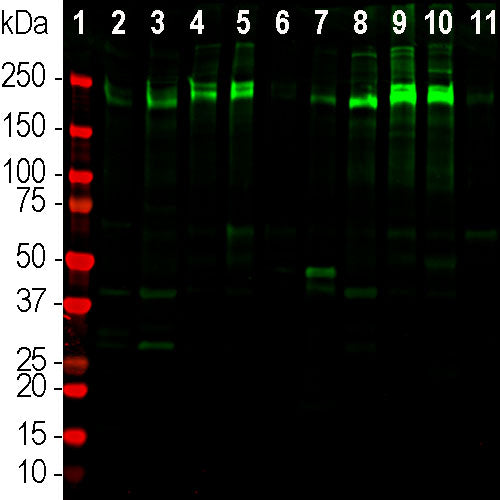
EnCor Biotechnology
Rabbit Polyclonal Antibody to Laminin, Cat# RPCA-Laminin
Description
The RPCA-Laminin antibody was made against laminin 111 isolated biochemically from mouse Engelbreth-Holm-Swarm (EHS) sarcoma cells (1,2). The antibody recognizes the several different laminin polypeptides on western blots and is a very useful reagent for visualizing basal lamina in mature and developing tissues. It is particularly useful in the CNS, allowing visualization of the basal lamina of endothelia, an important part of the blood brain barrier. Mouse select image above left for larger view.
Add a short description for this tabbed section
| Immunogen: | Laminin 111 preparation from mouse EHS sarcoma cells obtained from Sigma-Aldrich. |
| HGNC Name: | LAMA1, LAMB1, LAMC1 |
| UniProt: | P25391, P07942, P11047 |
| Molecular Weight: | 440kDa, 220kDa, 158kDa |
| Host: | Rabbit |
| Isotype: | IgG |
| Species Cross-Reactivity: | Human, Rat, Mouse |
| RRID: | AB_2572341 |
| Format: | Immunogen affinity purified antibody at 1mg/mL in 50% PBS, 50% glycerol plus 5mM NaN3 |
| Applications: | WB, IF/ICC, IHC |
| Recommended Dilutions: | WB 1:5,000. IF/ICC and IHC: 1:1,000-5,000. |
| Storage: | Store at 4°C for short term, for longer term store at -20°C. Stable for 12 months from date of receipt. |
Laminins are high-molecular weight proteins and major components of the extracellular matrix. They are an important part of the basal lamina a protein network typically separating cells and tissues of different embryonic origin. Laminin was first isolated biochemically from Engelbreth-Holm-Swarm (EHS) mouse sarcoma cells, a cell line which produces large amounts of extracellular matrix material (1,2). Laminins are heterotrimeric proteins that contain one of five α-chains, one of three β-chains and one of three γ-chains (3-4). The EHS sarcoma cell derived laminin was originally named laminin 1, composed of α1β1γ1 polypeptides (5), though a later nomenclature named this form laminin 111, the numbers indicating the content of α, β and γ gene products (6). The distribution of the different laminin isoforms is developmental time and tissue-specific and laminin-111 expressed in the embryonic epithelium, but is also expressed in adult kidney, liver, testis, ovaries and brain blood vessels (7). Genetic ablation of laminin-111 results in embryonic death (8), and point mutations in the human α1 gene resulted in Poretti Boltshauser Syndrome, a rare disorder associated with cerebellar abnormalities, ataxia, cognitive problems and other issues. Injection of laminin–111 into muscle appeared to be a promising therapy in a mouse model Duchenne muscular dystrophy (DMD, 9). However transgenic overexpression of the laminin α1 protein appeared to have no beneficial affect also in a mouse DMD model (10).
This antibody has been tested on formalin fixed paraffin embedded sections from human and rodent tissues and is not recommended for this purpose.
1. Timpl R, et al. Laminin--a glycoprotein from basement membranes. J. Biol. Chem. 254:9933-7 (1979).
2. Kleinman HK, et al. Isolation and Characterization of Type IV Procollagen, Laminin, and Heparan Sulfate Proteoglycan from the EHS Sarcoma. Biochemistry 21:6188-93 (1982).
3. Colognato H, Yurchenco PD. Form and function: the laminin family of heterotrimers.Dev. Dyn. 218:213-34 (2000).
4. Durbeej M, Laminins. Cell Tiss. Res. 339:259-268 (2010).
5. Burgeson RE, et al. A new nomenclature for the laminins. Matrix Biology 14:209-11 (1994).
6. Aumailley M, et al. A simplified laminin nomenclature. Matrix Biology 24:326-332 (2005).
7. Ekblom M, et al. Laminin isoforms and epithelial development. Ann. NY Acad. Sci. 857:194-211 (1998).
8. Alpy F, et al. Generation of a conditionally null allele of the laminin alpha1 gene. Genesis 43:59-70 (2005).
9. Rooney JE, Gurpur PB, Burkin DJ. Laminin-111 protein therapy prevents muscle disease in the mdx mouse model for Duchenne muscular dystrophy. PNAS 106:7991-6 (2009).
10. Gawlik KI, Oliveira BM, Durbeej M. Transgenic Expression of Laminin α1 Chain Does Not Prevent Muscle Disease in the mdx Mouse Model for Duchenne Muscular Dystrophy. Am. J. Pathol. 178:1728-37 (2011).
Add a short description for this tabbed section





